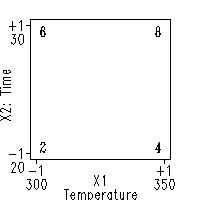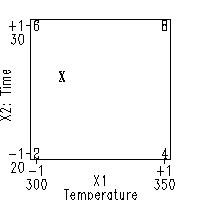5.
Process Improvement
5.5.
Advanced topics
5.5.9.
An EDA approach to experimental design
5.5.9.9.
Cumulative residual standard deviation plot
5.5.9.9.10.
|
Motivation: How do we Use the Model for
Interpolation?
|
|
|
Design table in original data units
|
As for the mechanics of interpolation itself, consider a continuation of
the prior k = 2 factor experiment. Suppose temperature T
ranges from 300 to 350 and time t ranges from 20 to 30, and the
analyst can afford n = 4 runs. A 22 full factorial
design is run. Forming the coded temperature as X1 and the
coded time as X2, we have the usual:
|
Temperature
|
Time
|
X1
|
X2
|
Y
|
|
300
|
20
|
-
|
-
|
2
|
|
350
|
20
|
+
|
-
|
4
|
|
300
|
30
|
-
|
+
|
6
|
|
350
|
30
|
+
|
+
|
8
|
|
|
Graphical representation
|
Graphically the design and data are as follows:

|
|
Typical interpolation question
|
As before, from the data, the prediction equation is
\( \hat{Y} = 5 + 2 X_{2} + X_{1} \)
We now pose the following typical interpolation question:
From the model, what is the predicted response
at, say, temperature = 310 and time = 26?
In short:
\( \hat{Y}(T = 310, t = 26) = \mbox{?} \)
To solve this problem, we first view the k = 2 design and data
graphically, and note (via an "X") as to where the desired
(T = 310, t = 26) interpolation point is:
|
|
Predicting the response for the interpolated point
|
The important next step is to convert the raw (in units of the
original factors T and t) interpolation point into a
coded (in units of X1 and X2) interpolation point. From
the graph or otherwise, we note that a linear translation between
T and X1, and between t and X2 yields
T = 300 => X1 = -1
T = 350 => X1 = +1
thus
|-------------|-------------|
-1 ? 0 +1
300 310 325 350
which in turn implies that
Similarly,
t = 20 => X2 = -1
t = 30 => X2 = +1
therefore,
|-------------|-------------|
-1 0 ? +1
20 25 26 30
thus
Substituting X1 = -0.6 and X2 = +0.2 into the prediction
equation
\( \hat{Y} = 5 + 2 X_{2} + X_{1} \)
yields a predicted value of 4.8.
|
|
Graphical representation of response value for interpolated data point
|
Thus
|




